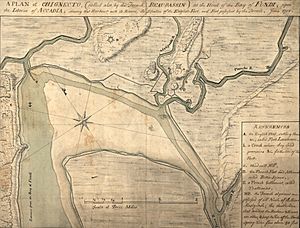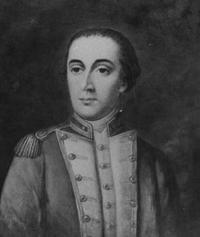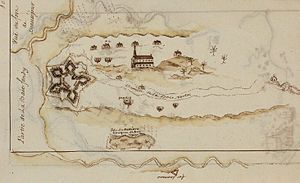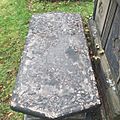Battle of Fort Beauséjour facts for kids
Quick facts for kids Battle of Fort Beauséjour |
|||||||
|---|---|---|---|---|---|---|---|
| Part of the French and Indian War | |||||||
 Robert Monckton by Benjamin West |
|||||||
|
|||||||
| Belligerents | |||||||
Mi'kmaq militia Acadian militia |
|||||||
| Commanders and leaders | |||||||
| Louis Du Pont Duchambon de Vergor | Robert Monckton George Scott Naval Captain John Rous John Winslow Jedidiah Preble Benjamin Goldthwait Winckworth Tonge |
||||||
| Strength | |||||||
| 162 troupes de la Marine 300 Acadian militia |
270 British army troops 2,000 New England militia |
||||||
| Casualties and losses | |||||||
| 8 killed, 6 wounded | 4 killed, 16 wounded | ||||||
The Battle of Fort Beauséjour was an important fight in 1755. It happened on the Isthmus of Chignecto, a narrow strip of land. This battle marked the end of a conflict called Father Le Loutre's War. It also started a big British attack in the area of Acadia and Nova Scotia. This attack was part of the larger Seven Years' War.
The battle helped change how people settled in the Atlantic region. It also set the stage for what is now the Canadian province of New Brunswick. On June 3, 1755, a British army led by Lieutenant-Colonel Robert Monckton began to attack Fort Beauséjour. They came from nearby Fort Lawrence. Their goal was to take control of the Isthmus of Chignecto. This area was very important for the French. It was the only way to travel between Quebec and Louisbourg during winter. After two weeks of fighting, the French commander, Louis Du Pont Duchambon de Vergor, gave up on June 16.
Contents
Why the Battle Happened
Tensions Between France and England
Long ago, in the 1600s, France started a colony called Acadia. This made them neighbors with the English in New England. There were often disagreements between them. One big problem was who owned certain land. After the English took over Acadia in 1710, the Isthmus of Chignecto was claimed by both sides. Today, Nova Scotia was claimed by the English. The Missaguash River was supposed to be the border. But Acadian people lived on both sides of it.
The English also claimed land in what is now New Brunswick and northern Maine. This land had some French people and Acadian settlements. Even so, the French King Louis XV encouraged Acadians to move west of the Missaguash River, closer to Fort Beauséjour.
Problems for New Englanders
In the 1750s, people in New England faced tough times. There was drought, economic problems, high taxes, and violence. Religious leaders used these problems to get support for an attack on the Catholic French. The English were also upset about the close ties between the French and the Mikmaq people. Acadians often married Mikmaq people. This created a unique local population. The English especially disliked that Acadians had the best land. They also didn't like the Mikmaq's support for the Acadians. This support stopped the English from building Protestant settlements.
The Role of Abbé Le Loutre
Abbé Le Loutre was a priest at Fort Beauséjour. He also worked for the French government and was allied with the Mikmaq. Le Loutre was very loyal to France. To make sure Acadians stayed loyal, he warned them of bad things if they went into English territory. Because of these threats, Acadians avoided supporting the English. Le Loutre also encouraged the Mikmaq to keep fighting against the British. They had been doing this since King William's War in 1689. The British even offered a reward for Le Loutre's capture.
British Concerns About Acadians
British leaders, like Lieutenant-Colonel Lawrence, believed the Acadians were not neutral. They had proof that some Acadians favored the French. Lawrence wanted all Acadians to promise loyalty to the English. People in New England saw Acadians as "traitors" to Britain. They hoped to move them to Philadelphia. Lawrence didn't care much for the Acadians' unique way of life or their neutrality.
Some historians think Lawrence wanted to clear good land for New Englanders. Others say the decision to move Acadians was mainly for military reasons. They wanted to remove any threat from Acadians who were allied with the Mi'kmaq and supported Louisbourg.
Start of the French and Indian War
In 1753, French troops from Canada moved south. They took and fortified the Ohio Valley. Britain said this was an invasion and claimed Ohio for itself. On May 28, 1754, the French and Indian War officially began. This started with the Battle of Jumonville Glen. A British patrol led by George Washington killed a French officer and some of his men. In response, the French and their Native allies defeated the British at Fort Necessity. Washington lost many men and surrendered.
In Acadia, the main British goal was to defeat the French forts at Beauséjour and Louisbourg. The British saw the Acadians' loyalty to the French and the Wabanaki Confederacy as a military danger. The fighting in Father Le Loutre's War had become very intense. British civilians had been attacked. Governor Charles Lawrence and the Nova Scotia Council believed Acadian civilians had helped the French by giving information, shelter, and supplies. Some Acadians had even fought against the British.
The British were worried about a French and Native invasion. Because of Native raids supported by the French, some British settlers left their homes. The Governor of Massachusetts, William Shirley, planned to take Fort Beauséjour. He believed attacking Beauséjour was the only way to protect Massachusetts.
Fort Beauséjour: Building and Spies
In 1750, the French Governor of New France, Jacques-Pierre de la Jonquière, heard that the English were building a fort in Acadia. This fort became Fort Lawrence. In response, the French decided to build Fort Beauséjour. Building started in 1751. The plans were made by a military engineer named Jacau de Fiedmont. He was in charge of building the fort and planning its defense. The fort was meant to be strong enough to resist attacks.
However, Fort Beauséjour was not fully finished by 1755. There were several reasons for this. First, the fort's priest, Abbé Le Loutre, moved workers to a water project instead. Also, Louis du Chambon de Vergor, the military commander in 1754, was more interested in keeping money for himself. So, he didn't use resources to strengthen the fort's defenses. Jacau de Fiedmont wrote in his journal that if the fort's defenses had been completed, it would have resisted attacks better. This would have also kept the French and Acadian defenders' spirits high. Fiedmont kept pushing for more work on the defenses because the fort was weak, but the work was never finished.
Another important person at Fort Beauséjour was Thomas Pichon. He had studied medicine in France. He was the commander's secretary at the fort. When many people at Fort Beauséjour got food poisoning, Pichon went to Fort Lawrence. He talked about his medical notes with the English surgeon. They figured out that a poisonous plant was being used instead of parsley in food.
Because of this, Pichon became friendly with the English at Fort Lawrence. He visited the fort often because he felt his work wasn't valued at Fort Beauséjour. Pichon didn't trust Commander Vergor or the priest Abbé Le Loutre. Even though Le Loutre was below Vergor, he was really in charge. Pichon eventually met the commander at Fort Lawrence, Captain George Scott, and was hired as a spy. Pichon said he became a spy because he thought the British were better than the French. But it's more likely he wanted money and disliked his bosses at Fort Beauséjour. For a year before the siege, Pichon gave important military information, like maps and battle plans, to the English. Some Acadians also spied for the British. After 1755, Thomas Pichon started a new life as Thomas Tyrell, a subject of King George II. Later in life, Pichon regretted betraying the French.
The Siege of Fort Beauséjour
Colonel Shirley of Massachusetts was in charge of getting soldiers for the attack on Beauséjour. He gathered 2,000 men. They would be led by Colonel Winslow, Lieutenant-Colonel George Scott, and Robert Monckton. The group left Boston on May 22, 1755. They arrived at Fort Lawrence on June 2, where 400 more men joined them. The English then started moving towards Fort Beauséjour on June 4.
Meanwhile, Vergor heard about the coming attack. He began to set up defenses. He called on the Acadian people nearby to help. They answered, but not happily. The Acadians asked their governor to threaten them. This way, they would be protected from being executed by the English for treason. Fort Beauséjour had about a thousand men to defend it. Vergor also sent letters asking for help from Quebec, Louisbourg, and other settlements. He also sent a letter to Fort Gaspereau, which was closest to Fort Beauséjour. While Vergor was technically in charge, Jacau de Fiedmont planned all the defenses. He knew the fort could only survive if its defenses were stronger. He insisted that extra work be done before the English arrived. Other preparations included destroying roads and bridges.
The first fight between the French and English happened on June 4 at the Missaguash River. About 400 French, Acadian, and Native men faced British soldiers. It was clear that the Acadians were not good fighters. They lacked motivation. This showed the English how weak Fort Beauséjour was. After the fight, it was said that the English lost eighty men. But this was likely made up to boost the Acadians' low morale. The English started rebuilding the bridge over the Missaguash River. Vergor had destroyed it under fire, but the English suffered no casualties.
On the night of June 4, Vergor continued to set up defenses. This time, he set fire to all the surrounding buildings, shops, and homes. This did not help the Acadians' morale, as these were their homes. Vergor, Abbé le Loutre, and Fiedmont tried everything to improve the morale of the Acadians and soldiers. Vergor stressed that help was coming from Louisbourg. Fiedmont also worried about the Acadians' motivation. He desperately needed them to work on the defenses. The few men who were willing to work were not enough.
On June 7 and 8, Native allies of the French captured an English officer named Hay. They brought him to Fort Beauséjour as a prisoner. An English deserter was also captured. The English officer told the French that the English had a very strong force and powerful cannons. On June 9, heavy rain gave the Acadians another excuse not to work on defenses. But the English kept building their trenches and preparing for the siege. On June 11, Fiedmont tried again to motivate the Acadians to finish the defenses, but it didn't work. On June 12, an officer named Vannes left with 180 men to attack Lieutenant Colonel Scott. But he came back that night without firing a single shot. This did not help the morale of his fellow officers and soldiers.
The English started bombing Beauséjour on June 13. Their cannons were much stronger than anything Beauséjour had. The men at Fort Beauséjour quickly lost what little hope they had left. Many Acadians simply left the fort.

On June 14, Vergor heard that the port of Louisbourg was blocked by the English. This meant no help could be sent. Since morale was already very low, Vergor decided to keep this news a secret. However, his servant overheard and spread the news. The next day, all the Acadians and soldiers had completely lost hope. They started pushing for the fort to surrender. In fact, after hearing the news, eighty men left Beauséjour. Leaving the fort became such a big problem that orders were given to forbid men from even talking about it.
Many Acadians who hadn't fought were worried they would be captured and sentenced to death by the English. Beauséjour continued to be bombed until June 16. One bomb hit the officers' mess. It killed a few French officers and the English prisoner Hay. Hay was the only Englishman to die in the siege. The white flag of surrender was then raised. The surrender agreement was signed on June 16, 1755. The agreement protected the Acadians. It also said what the English could take from Beauséjour. It stated that the French could not fight in America for the next six months.
The English took control of Fort Beauséjour at 7:30 p.m. on June 16. The English offered Fort Gaspereau the same terms, which were accepted right away. After the battle, Robert Monckton sent a group led by John Rous to take Fort Menagoueche. De Boishebert knew he faced a stronger force. So he burned the fort and went up the river to fight using guerrilla tactics. The destruction of Fort Menagoueche left Louisbourg as the last French fort in Acadia. Boishebert made his first attack in the Battle of Petitcodiac.
What Happened Next
The capture of Fort Beauséjour greatly changed relations between the British and the Acadian people. For many years, Britain had tried to get the Acadians to promise loyalty. But the Acadians said that agreements from 1730 meant they would stay neutral in any future wars between England and France. This refusal, along with French colonists trying to start rebellions among their fellow French-speakers, made British officials very suspicious. Governor Charles Lawrence was especially worried about an attack from within.
The Battle of Fort Beauséjour sealed the Acadians' fate. With the fort captured, the French Catholics lost their only land escape route. They had also given up their guns to Lawrence. This left the Acadians "at the mercy of their British overlords." The British found that several Acadians had helped defend Beauséjour. Lawrence had enough proof that some Acadians were not neutral. So, he and the Council decided to solve the "Acadian problem" once and for all. On July 31, 1755, he ordered the forced removal of the Acadian people from the colony.
Historians have discussed what the British might have planned for Acadia before taking Beauséjour. By refusing to promise loyalty, Acadians had long resisted becoming part of the British Protestant way of life. Lawrence's letters show he was very hostile towards the Acadians by 1754. At that time, he was planning with Massachusetts Governor William Shirley to bring British soldiers into Nova Scotia. Like many governors before them, Lawrence and Shirley had often talked about moving the Acadians. But before 1755, they didn't have the means to do it. If General Edward Braddock hadn't been defeated that same year, Lawrence might have extended British control beyond Acadia. This might have removed the need for a mass deportation.
The British renamed Fort Beauséjour to Fort Cumberland. It quickly became a main place for the Acadian expulsion. But it didn't see much fighting during the rest of the Seven Years' War. The fort would face another siege in 1776 during the American Revolution, known as the Battle of Fort Cumberland.
Images for kids
-
Peregrine Lascelles, commander of 47th regiment
-
Winckworth Tonge fought in Battle, Old Burying Ground (Halifax, Nova Scotia)
See also
 In Spanish: Batalla de Fort Beauséjour para niños
In Spanish: Batalla de Fort Beauséjour para niños










